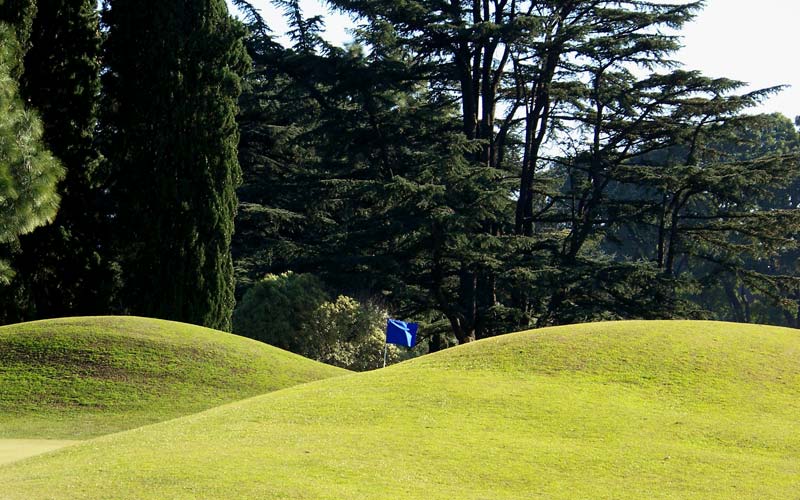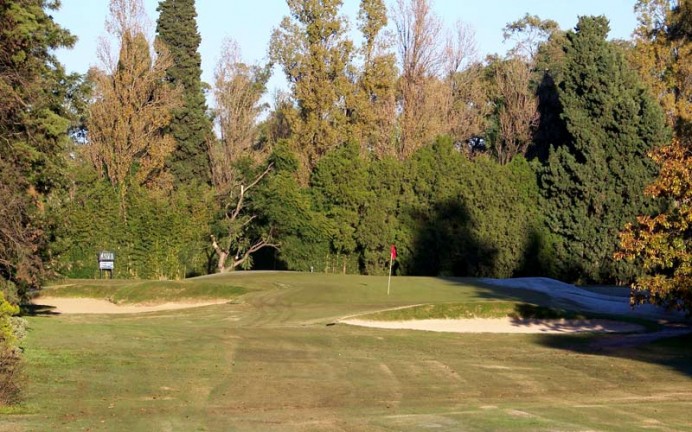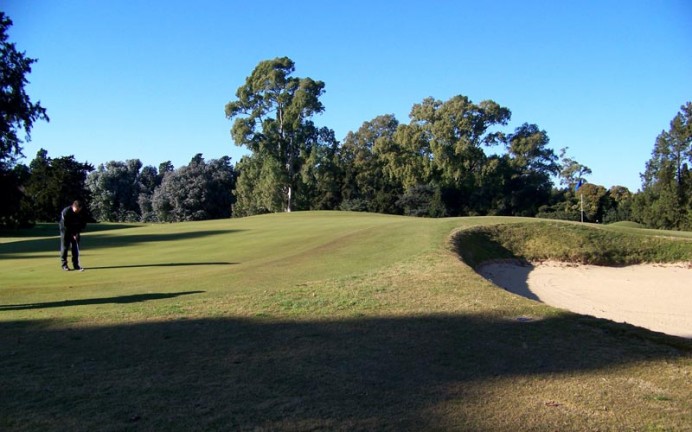Jockey Club Golf (Cancha Colorada)
Buenos Aires, Argentina
Of all the countries in South America, Argentina enjoys the richest golfing history. Before the turn of the nineteenth century, Brits came to Argentina to help develop the infra-structure of the country such as train lines. As far away as four hundred kilometers from Buenos Aires, class golf courses like Mar del Plata were being built pre-1900. To this day at Mar de Plata, the golfers contend with canted, non-irrigated fairways and deep, sleeper-lined bunkers. Suffice to say, the spirit of golf has been alive and well in Argentina for over a century.
The Jockey Club itself was founded in 1882 (!). At the time, golf was not included but horses were and the Club set the tone for equestrian activities across Argentina. Already the social center for high society in Argentina, the Club decided to add golf to its offering. Over 315 hectares (approximately 785 acres) were acquired in 1925 on what was then the outskirts of Buenos Aires (today the sprawling city of twelve million now engulfs the perimeter of the property).
The Club had the great sense to contact Alister Mackenzie in the late 1920s to see what interest he had in designing two equal eighteen hole courses. Mackenzie at the time was living in California and had already designed three of his four original masterpieces: Cypress Point, Crystal Downs and Royal Melbourne (Augusta National would follow several years later).
With North America in the grips of the Great Depression, Mackenzie had nothing to keep him there and delightedly made his way by boat to Buenos Aires. Once there, there was no rush to return and consequently, both courses at The Jockey Club are the beneficiaries of his full attention.
The property at San Isidro was dead flat. How would Mackenzie handle such a site? After all, here was a man accustomed to working with such feature rich sites as Lahinch and Pasatiempo.
Along with Bob Jones, Mackenzie may be considered the The Old Course at St. Andrews’ greatest admirer. At some point early on, Mackenzie made a connection between the wide expanse of short grass at St. Andrews and the potential for a wide expanse of short grass at San Isidro. In regards to the construction of the Cancha Colorada (Red Course) and the Cancha Azul (Blue Course), Mackenzie writes in The Spirit of St. Andrews:
We made the ground extremely undulating by constructing a series of irregular swales radiating to the lowest point, and these swales gave us the following advantages: they cheapened and facilitated the drainage. They gave us plenty of soil for making greens and creating undulating ground, and above all, they gave the place a natural appearance that the undulations appear to have been created by the effects of wind and water thousands of years ago. The course has a greater resemblance not only in appearance but in the character of its golf to the Old Course at St. Andrews than any inland course I know.
Assisting Mackenzie during construction was Luther H. Koontz, an engineer specializing in drainage and irrigation. Koontz stayed behind in South America and went on to build the nearby Olivos Golf Club, another class Argentine course made famous by hosting big events.
Mackenzie was justly proud of the random humps and bumps and swales and hollows that they created. He continues on in The Spirit of St. Andrews:
When we had completed the contouring of this course, which incidentally was done in twenty-one days, the captain of the club, a very able man and a student of golf architecture, asked me what I was going to do about the bunkering. I replied ‘The undulations have created such a varied, interesting and pleasurable test of golf that we do not require a single bunker; nevertheless, for the sake of appearance and for the purpose of creating more spectacular thrills we will give you a few bunkers.
The challenge of St. Andrews for the better player lies in its short grass even more so than the numerous bunkers randomly scattered across its holes. In recent Opens at St. Andrews, Tiger Woods and Nick Faldo managed their way around the course by getting into only one bunker between them over 144 holes. The persistent challenge at St. Andrews is negotiating the humps and bumps when the course is running fast and firm. One almost senses from MacKenzie’s comment above that he would have left the course, or at least one of the courses, without a single bunker, so convinced was he of the merit of the undulations that they had created.
By undulations, this includes the green complexes themselves, which are astonishingly diverse. The greens range from famous ones featuring the pronounced mounds (e.g. the thirteenth and sixteenth) to ones that seamlessly rise up from the fairway with fall offs over (e.g. the sixth and fourteenth) to others that hug the ground and appear as mere extensions of the fairway (e.g. the eighth and ninth). This variety of green complexes allows the golfer to play all sorts of approach shots, a most desirable attribute.
The expansive, links-like feel that The Red Course once enjoyed has been altered as many hardwood and pines have been planted since Mackenzie’s day. They are generally out of play and do provide a handsome backdrop for one’s game. Nonetheless, they define the broad playing corridors, something not found at The Old Course.
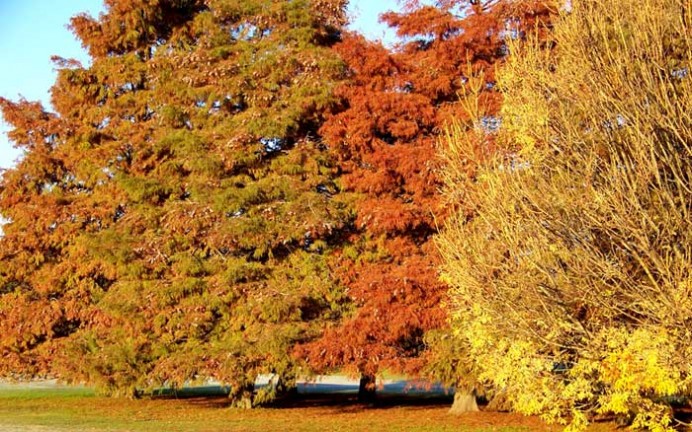

Holes to Note
First hole, 425 yards; Creating contours that appear based in nature is one of the hardest challenges that architects face in the field. Mackenzie took obvious pride in how they turned a flat site with less than three feet of elevation change into a site with both better golf qualities as well as visual appeal. One gains the greatest appreciation of the work carried out by Mackenzie and Koontz on some of the longer holes, such as here and the three shot fifteenth.The early morning frost highlights the ground contours created by Mackenzie and Koontz.
Second hole, 350 yards; One of the great pleasures in playing a Mackenzie course is getting to see and study his sub-400 yard holes. Mackenzie’s design mantra was all about variety and creating pleasurable excitement; it was not about beating the golfer senseless. His superlative short two shotters go a long way in differentiating his courses from all other architects.

The golfer relative to the mown putting surface at the second indicates the height that Mackenzie built up the green pad. Though the frost hides it in the photograph above…
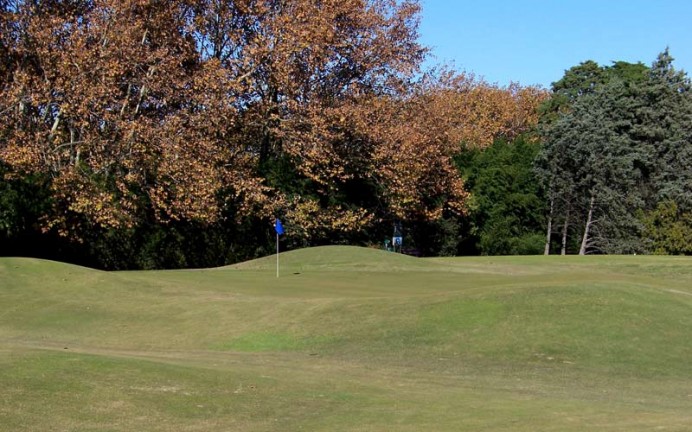

Third hole, 150 yards; Good players tend to gauge the distance correctly many more times than not. When they miss, it is directionally, either to the left or right. Appreciating this fact, Mackenzie built the two shortest one shotters on the course (here and the seventeenth) with long narrow greens. There are many ways to bogey this hole, regardless of one’s talent. Even the best struggle mightily to get the ball up and down from the sides of these holes.

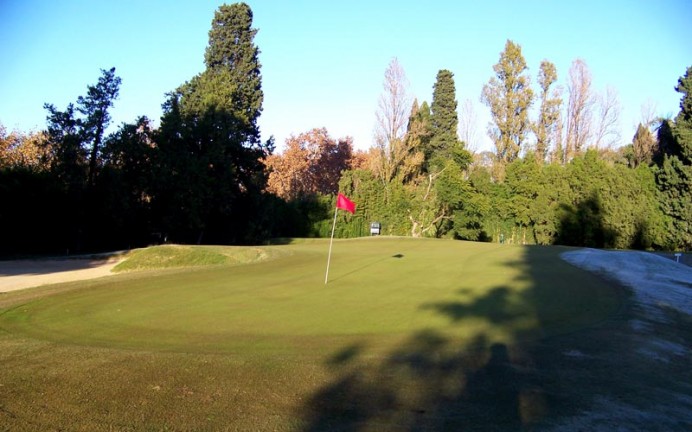
Seventh hole, 425 yards; The green makes this straight hole the hardest two shotter on the front. Born in Scotland, Mackenzie studied the famous links holes in the United Kingdom. One of their more unusual attributes is the severity of the green complexes on some of the longest two shot holes. Famous examples outside of St. Andrews include Sea Hedrig at Prestwick and the third at Brancaster. Mackenzie employed the concept of a frightening green to punctuate some of his all time best long two shotters, including the sixth on the West Course at Royal Melbourne and the thirteenth at Crystal Downs. Here too, the green makes very exacting requirements on the golfer, though of course Mackenzie left the right open for a running approach shot.
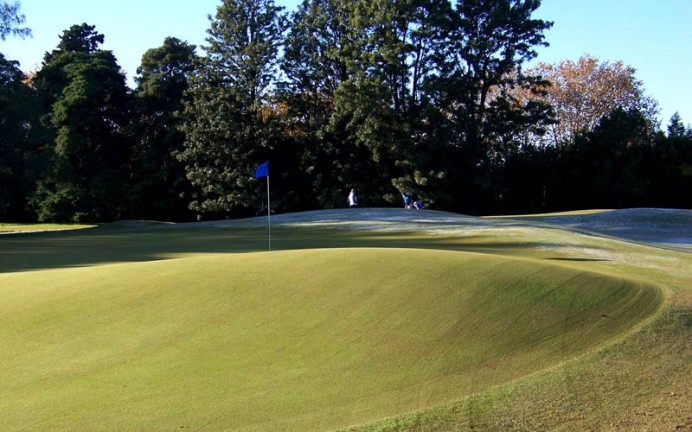
Tenth hole, 470 yards; Famous the world over, this half par hole has infuriated great golfers for over seventy-five years. Certainly given the advances in technology today, this hole is within reach with two blows. However, the oblique angle of the green to the fairway combined with a deep bunker along the right of the green creates maddening angles of play, in some ways the mirror image to the Road Hole green and bunker at St. Andrews. The hole location changes the day’s playing average of this hole by nearly a full stroke. Place it back right behind the deep bunker and many 5’s are carded. Place it in a more accessible location and 3’s can be had. Mackenzie defends par at the green as well as any architect in the history of the game and this is a sterling example of his talent at doing so.
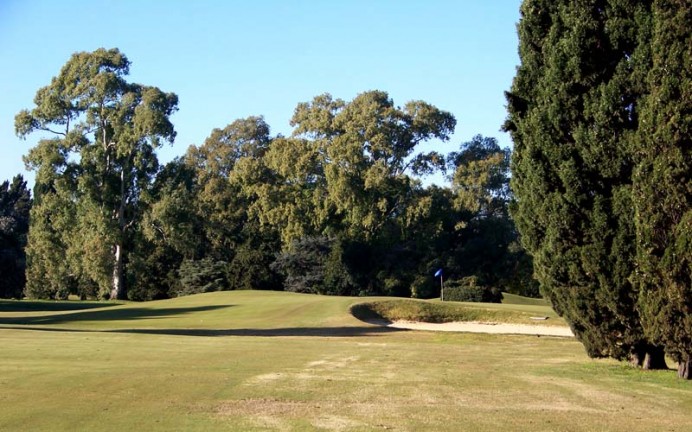
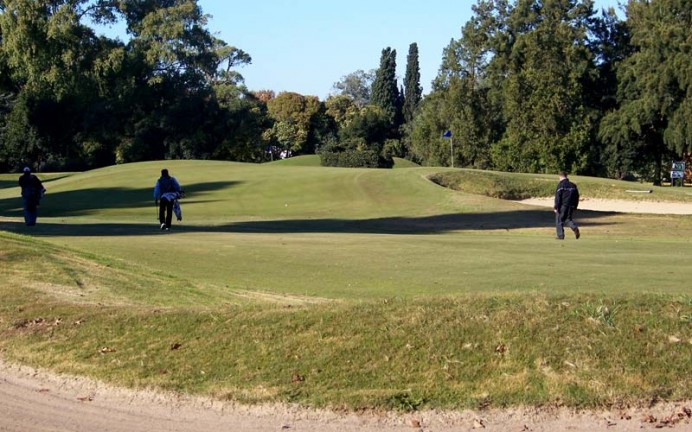
Twelfth hole, 175 yards; Though handsomely framed by trees at the perimeter of the property, the golf architecture student senses the influence of the Eden hole on this design. The front left and right bunkers are separated by the green’s false front.
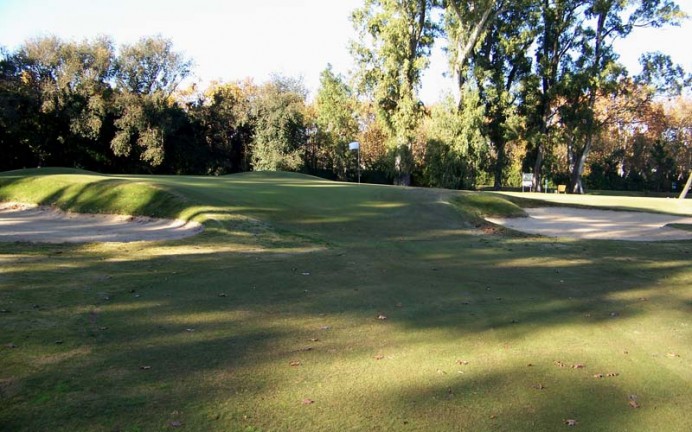
Thirteenth hole, 445 yards; Mackenzie writes again in The Spirit of St. Andrews, ‘There is a great fascination in playing a shot with a maximum of topspin and seeing one’s ball climbing over hillocks, through hollows, curving right to left, or left to right, and finally lying dead at the hole. There is the feeling suspense in wondering whether it is going to climb the last rise, followed by a feeling of intense relief when it just makes it and rolls down the final slope towards the hole.’ As anyone knows that has played The Old Course, that sentiment summarizes the timeless appeal of golf at St. Andrews. Mackenzie instilled that same sense of fun and anticipation into both courses at The Jockey Club, a feat worthy of great recognition.


Fifteenth hole, 510 yards; A fascinating fairway, as its rippling contours appear to have been there for ages. The random nature of the mounds and swales is in stark contrast to the use of mounds employed by many modern American architects, especially during the period of 1985 through 2005. The American architects erred by lining their fairways with parallel mounds while leaving the fairways themselves with minimal contours. The result is painfully artificial and lacks any strategic or playing merit. Mackenzie in the meanwhile focused on contouring within the confines of the fairway where it matters most (i.e. where the game is supposed to be played!). One day, one’s ball may be slightly above one’s feet; the next day, the ball slightly below. Having to make minor tweaks to one’s stance and set-up from round to round has helped keep this hole – and the course – fresh for generations of well-heeled Argentines.
Sixteenth hole, 400 yards; In a field, three enormous mounds emerge to ring the sixteenth green. The sensation created is of hitting one’s approach shot into a punchbowl green more commonly found in the United Kingdom. This unexpected turn in the course both surprises and delights the golfer. Tom Doak in The Life and Work of Dr. Alister Mackenzie calls the effect ‘a bit like bumper pool.’ The long green is narrower in front and bulges out beyond the mound along the green’s right side. Played round after round, year and year, all kinds of stories emerge regarding approach shots being caromed this way or that off these tightly mown mounds. Plus, one’s imagination is the only limit to how one uses the mounds in recovering from a missed approach. The stark artificiality of the green complex is everything that Mackenzie stands against as an architect; conversely, the amount of fun and the way the green complex encourages one to invent never before tried shots is pure Mackenzie.
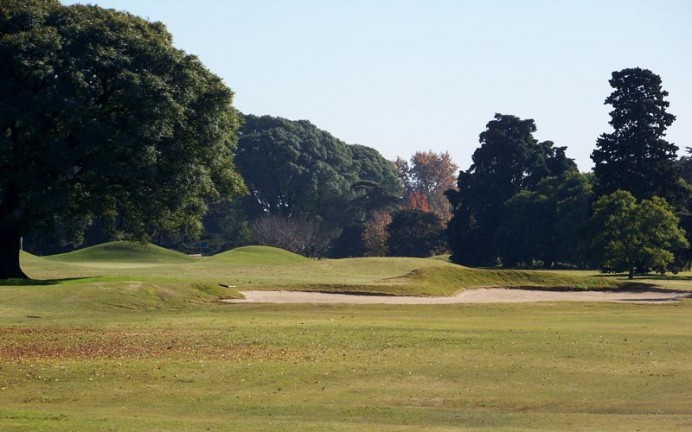
Even from 400 yards back on the tee, the pronounced mounds surrounding the sixteenth green are evident.
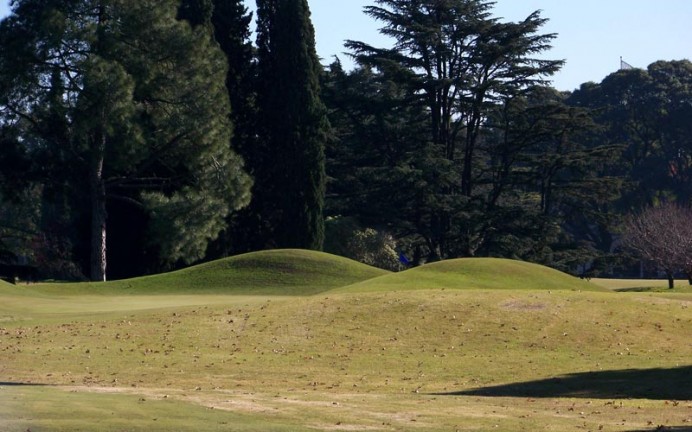
The blue flag is between the two mounds – having to drop one’s approach shot between the mounds is one of the most fun shots on the course.
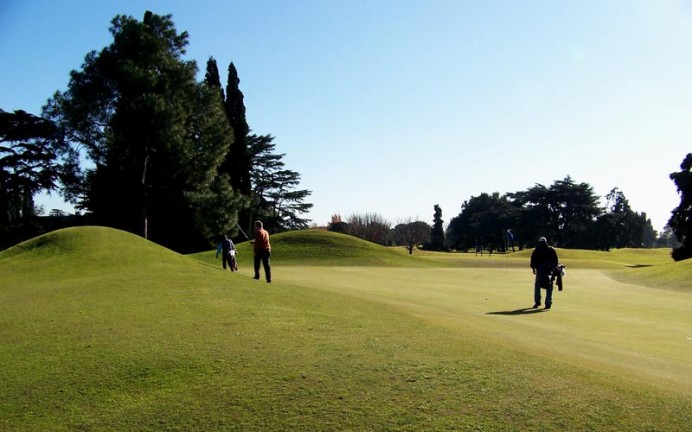
The sixteenth green is slender in front before widening toward the back. Congratulations to The Jockey Club for continuing to commit the resources to maintaining the mounds as short grass. Without doing so, many of the recovery options would be lost and the joy of the hole would be snuffed out.
Seventeenth hole, 170 yards; Even more so than the one shot third, the pushed up green makes for an extremely exacting target. The first third of the green is a scant eight (!) paces wide with bunkers left and a tightly mown bank right. Mention has been made of this hole being a Redan but the author doesn’t see it.
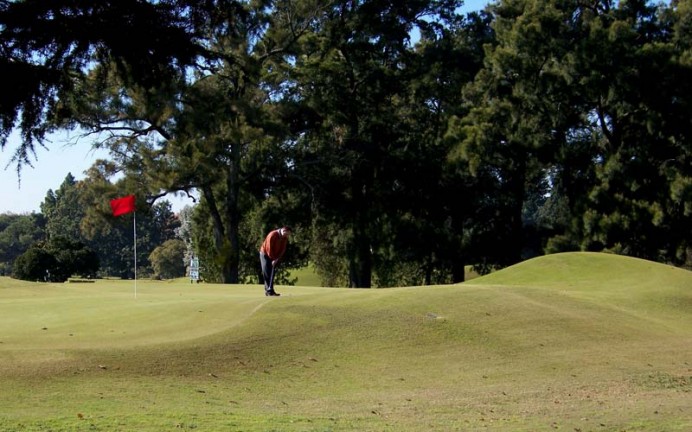
Golfers that miss the seventeenth green to the right must manufacture some sort of nervy recovery, never easy on the penultimate hole.
Eighteenth hole, 355 yards; For many traditionalists, The Old Course at St. Andrews sets the perfect tone with its closing two holes: an exacting penultimate hole followed by a Home hole that allows the golfer to finish on a positive note. Such is clearly the case here and there is no way it wouldn’t be given how much the Old Course was in the forefront of Mackenzie’s mind throughout his dealings at The Jockey Club. Straight from St. Andrews, the Home hole here is bunkerless with its own version of the Valley of Sin. This hole perfectly captures the essence of Red Course at The Jockey Club: not overly long and within reach of everyone yet it requires care and thought in playing it well. Somehow, an extra stroke is taken more times than one wishes. In every respect, this is the perfect closing hole for a course so full of pleasurable excitement and charm. Pity more modern architects don’t have the courage to so end their courses.
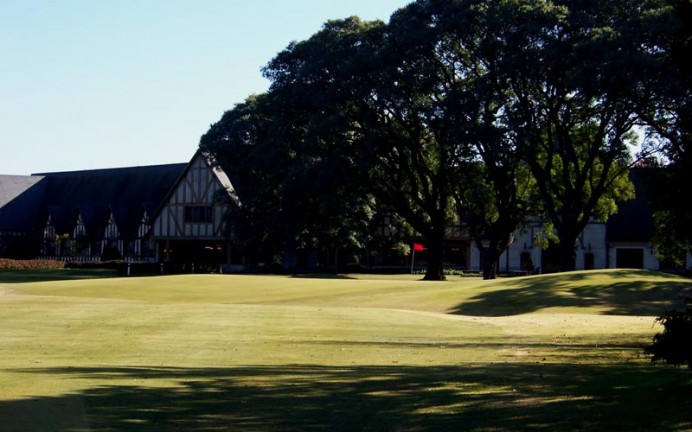

Apart from acknowledging The Jockey as being one of – or perhaps the – great sporting club, how can one summarize the golf offering only? The greatest golf course architect of all-time borrowed a number of design attributes from his favorite golf course and successfully translated them into the dirt at San Isidro. His features remain well preserved to this day. As one walks down the fourth and fifth fairways listening to horses thunder past on the Club’s adjacent track, one realizes this is a unique place in world golf. Polo has long been referred to as the Sport of Kings, which is exactly how one feels regarding golf when fortunate enough to have a game here at The Jockey Club.
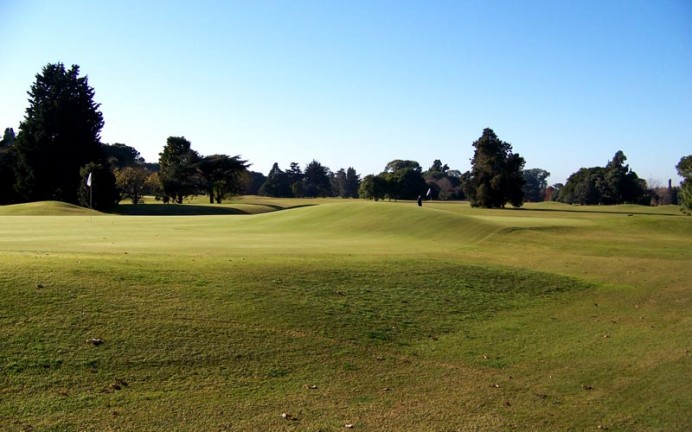

The End


